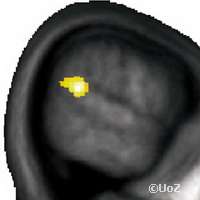Volume of grey matter may predict degree of altruism

What makes a person altruistic? Philosophers throughout the ages often pondered the question but failed to get concrete answers. New research from the University of Zurich in Switzerland shows that the answer may lie in our brains, or more accurately, that the volume of a small brain region can influences one's predisposition for altruistic behaviour. The results, presented in the journal Neuron, indicate that individuals who behave more altruistically than others have more grey matter at the junction between the parietal and temporal lobe. This shows for the very first time that there is a connection between brain anatomy, brain activity and altruistic behaviour.
Contary to past studies that showed that social categories like gender, income or education cannot fully explain differences in altruistic behaviour, recent research in the area of neuroscience have demonstrated that differences in brain structure might be linked to differences in personality traits and abilities. Now, for the first time, a team of researchers from the University of Zurich, headed by Ernst Fehr, the director of the Department of Economics, demonstrates that there is a connection between brain anatomy and altruistic behaviour.
For their study, the researchers asked volunteers to divide money between themselves and someone else who was anonymous. The participants always had the option of sacrificing a certain portion of the money for the benefit of the other person. The monetary sacrifice was considered to be altruistic because it helped someone else at one's own expense. The researchers found major differences in this respect: some participants were almost never willing to sacrifice money to benefit others while others behaved very altruistically.
Previous studies showed that the place where the parietal and temporal lobes meet is linked to the ability to put oneself in someone else's shoes in order to understand their thoughts and feelings, an ability the researchers considered closely related to altruism.
So the team hypothesised that individual differences in this part of the brain might be linked to differences in altruistic behaviour. And, according to Yosuke Morishima, a postdoctoral researcher at the Department of Economics at the University of Zurich, they were right: 'People who behaved more altruistically also had a higher proportion of grey matter at the junction between the parietal and temporal lobes.'
The researchers also discovered that the subjects displayed marked differences in brain activity while they were deciding how to split up the money. In the case of selfish people, the small brain region behind the ear is already active when the cost of altruistic behaviour is very low. In altruistic people, however, this brain region only becomes more active when the cost is very high. The brain region is activated especially strongly when people reach the limits of their willingness to behave altruistically. The reason, the researchers suspect, is that this is when there is the greatest need to overcome man's natural self-centeredness by activating this brain region.
Said Dr Fehr: 'These are exciting results for us. However, one should not jump to the conclusion that altruistic behaviour is determined by biological factors alone.'
It appears that the volume of grey matter can also be influenced by social processes. According to Dr Fehr, the findings therefore raise the question as to whether it is possible to promote the development of brain regions that are important for altruistic behaviour through training or social norms.
More information: Morishima, Y., et al. 'Linking brain structure and activation in the temporoparietal junction to explain the neurobiology of human altruism'. Neuron. 2012.


















